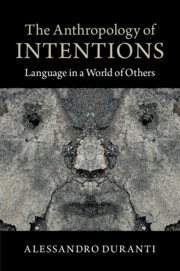Book contents
- Frontmatter
- Contents
- List of figures
- Acknowledgments
- 1 Rethinking anti-intentionalism
- 2 Intentions in speaking and acting: the Standard Theory and its foes
- 3 The avoidance of intentional discourse: a Samoan case study
- 4 The invention of promising in the Samoan translation of the Bible
- 5 Intentionality and truth, revisited
- 6 Speaker intentions and the role of the audience in a political campaign in the US
- 7 A dialogue on intentions
- 8 Opacity of other minds: local theories revisited
- 9 Intentions and their modifications: a lesson from Husserl
- 10 A sense of the other: from intentionality to intersubjectivity
- 11 The intentional continuum
- Appendix A Transcription conventions for English examples
- Appendix B Transcription conventions and abbreviations used in the Samoan examples
- Notes
- References
- Index
11 - The intentional continuum
Published online by Cambridge University Press: 18 December 2014
- Frontmatter
- Contents
- List of figures
- Acknowledgments
- 1 Rethinking anti-intentionalism
- 2 Intentions in speaking and acting: the Standard Theory and its foes
- 3 The avoidance of intentional discourse: a Samoan case study
- 4 The invention of promising in the Samoan translation of the Bible
- 5 Intentionality and truth, revisited
- 6 Speaker intentions and the role of the audience in a political campaign in the US
- 7 A dialogue on intentions
- 8 Opacity of other minds: local theories revisited
- 9 Intentions and their modifications: a lesson from Husserl
- 10 A sense of the other: from intentionality to intersubjectivity
- 11 The intentional continuum
- Appendix A Transcription conventions for English examples
- Appendix B Transcription conventions and abbreviations used in the Samoan examples
- Notes
- References
- Index
Summary
Introduction
In this concluding chapter I argue that, rather than discouraging any use of “intentions,” the various cross-cultural, cross-linguistic, and historical analyses presented in the prior chapters have shown the need to formulate a more contextually rich and contextually sensitive notion of intentionality as a pan-human capacity to attend to all kinds of real and imagined entities while giving them meaning. I believe that some notion of intentionality – and thus some notion of “intention” – is needed if we want to make sense of how people orient themselves in the social world, anticipate the actions of others, and follow their own instincts, intuitions, moods, needs, and desires. Rather than just being another “language game” (Wittgenstein 1958), a discussion of “intentions” – which includes a critical stance toward it – is important for an anthropological understanding of human agency as constrained by existing relations of power and yet sometimes resistant to long-established institutional practices. One lesson of our interpretive journey has been that the reliance on intentions and their apparent avoidance must always be contextualized. The notion of “intentional continuum” will be here introduced as a way of making sense of the contextual variability in intentional action that I documented in this book.
The meaning of intentions and their uses
As discussed in Chapter 2, three prominent philosophers of language used the notion of “intention” to explain how people make sense of what someone means in saying something. I called this view the “Standard Theory.” It adopts a commonsense notion of intending to characterize a relationship of agency and (sometimes) responsibility between persons and their acts. Within the “Standard Theory,” there are some differences. Grice (1957) used the verb intend to explain what makes a given utterance meaningful for both speakers and hearers. Austin (1962, 1975) used “intention” in his “felicity conditions” for all kinds of speech acts, including promises. Searle (1983) went beyond speech, extending the use of intentions to provide his own definition of what counts as “action.”
- Type
- Chapter
- Information
- The Anthropology of IntentionsLanguage in a World of Others, pp. 233 - 242Publisher: Cambridge University PressPrint publication year: 2015



